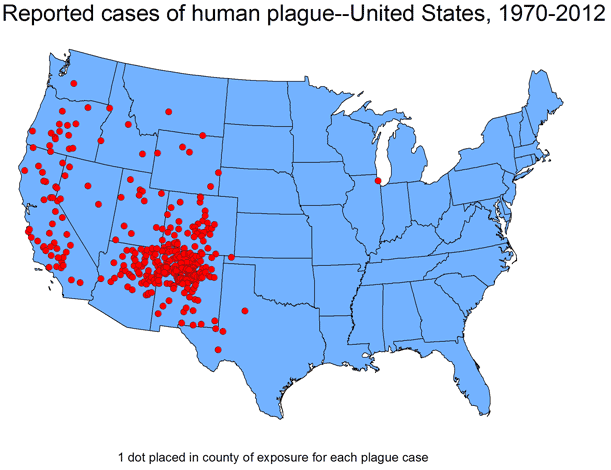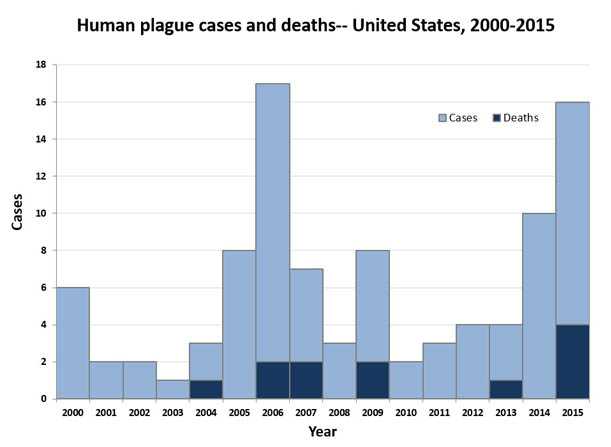Maps and Statistics
Plague in the United States
Plague was first introduced into the United States in 1900, by rat–infested steamships that had sailed from affected areas, mostly from Asia. Epidemics occurred in port cities. The last urban plague epidemic in the United States occurred in Los Angeles from 1924 through 1925. Plague then spread from urban rats to rural rodent species, and became entrenched in many areas of the western United States. Since that time, plague has occurred as scattered cases in rural areas. Most human cases in the United States occur in two regions:
- Northern New Mexico, northern Arizona, and southern Colorado
- California, southern Oregon, and far western Nevada

Plague cases in the United States, 1970–2012. Since the mid–20th century, plague in the United States has typically occurred in the rural West. The case shown in Illinois was lab-associated.

Human plague cases and deaths in the United States, 2000 to 2015.
Between 1900 and 2012, 1006 confirmed or probable human plague cases occurred in the United States. Over 80% of United States plague cases have been the bubonic form. In recent decades, an average of seven human plague cases have been reported each year (range: 1–17 cases per year). Plague has occurred in people of all ages (infants up to age 96), though 50% of cases occur in people ages 12–45. It occurs in both men and women, though historically is slightly more common among men, probably because of increased outdoor activities that put them at higher risk.

Number of confirmed and probable plague cases per year in the United States: 1900-2012.
Plague Worldwide
Plague epidemics have occurred in Africa, Asia, and South America but most human cases since the 1990s have occurred in Africa. Almost all of the cases reported in the last 20 years have occurred among people living in small towns and villages or agricultural areas rather than in larger towns and cities. Between 1,000 and 2,000 cases each year are reported to the World Health Organization (WHO), though the true number is likely much higher. It is hard to assess the mortality rate of plague in developing countries, as relatively few cases are reliably diagnosed and reported to health authorities. WHO cites mortality rates of 8–10%, however some studies (WHO, 2004) suggest that mortality may be much higher in some plague endemic areas.

Distribution of plague cases, worldwide. Data from WHO.
- Page last reviewed: September 14, 2015
- Page last updated: November 29, 2016
- Content source:


 ShareCompartir
ShareCompartir